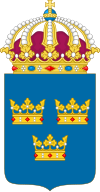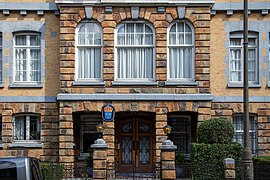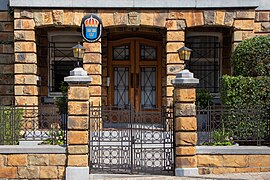| Embassy of Sweden, Brussels | |
|---|---|
 | |
| Location | Brussels |
| Address | Sweden House, Rue du Luxembourg 3, BE-1000, Brussels |
| Coordinates | 50°50′25″N 4°22′01″E / 50.840283°N 4.367046°E / 50.840283; 4.367046 |
| Opening | 1837 |
| Closed | 1 July 2011 |
| Jurisdiction | |
The Embassy of Sweden, Brussels was the diplomatic mission of Sweden in Brussels between 1837 and 2011. The mission was elevated from legation to embassy in 1956. The embassy in Brussels had a bilateral role, focusing on enhancing Sweden's relations with Belgium. It housed a consular section offering services to Swedish citizens and individuals with Swedish connections. Additionally, the embassy hosted the Swedish Trade Council's office as its trade section. The ambassador's responsibilities included maintaining continuous dialogue with the Belgian government, especially regarding EU affairs, and fostering economic and cultural ties between Belgium and Sweden. Since 2011, a Stockholm-based ambassador has been responsible for the bilateral relations between Sweden and Belgium. In 2020, Sweden opened a consulate general in Brussels with a focus on consular activities.
History
The diplomatic mission in Brussels was established in 1837. From 1869 to 1895, the mission was shared with The Hague, Netherlands, located in the latter city and covering both states. Until 1921, the envoy in Brussels had a dual accreditation in The Hague.
During World War II, the envoy post was vacant between 1942 and 1944. From 1 April 1944, Gunnar Hägglöf served as envoy extraordinary and minister plenipotentiary to the Belgian government in exile and the Dutch government-in-exile in London. In November of the same year, the Swedish mission in Brussels resumed its operations after Hägglöf returned there from London. The Swedish properties in Belgium were relatively unscathed during the war. The mission and consulate general in Brussels, the consulate general in Antwerp, as well as the Seamen's Church and other Swedish institutions, were undamaged.
In March 1956, an agreement was reached between the Swedish government and the Belgian government to mutually elevate each other's legations to embassies. In connection with this, the Swedish government appointed the then envoy Gunnar Reuterskiöld as ambassador.
During the 2010s, the Swedish embassy in Brussels received the "Entreprise écodynamique" accolade, which was an official recognition and reward for environmental awareness for both public and private companies in the Brussels region. As the only embassy in Brussels, the Swedish embassy was awarded a first star and could then be called - Entreprise écodynamique.
On 22 December 2010, the Reinfeldt cabinet decided to close the embassy in Brussels, along with four other Swedish embassies. According to Foreign Minister Carl Bildt, the decision was a consequence of the Riksdag deciding to cut the grant to the Government Office by SEK 300 million. The embassy closed on 1 July 2011. Since 2011, a Stockholm-based ambassador has been responsible for the bilateral relations between Sweden and Belgium. On 2 November 2020, Sweden opened a consulate general in Brussels. The consulate general's focus is consular activities, including ensuring readiness to assist individuals in crisis or disaster situations.
Staff and tasks
Staff
Further information: List of ambassadors of Sweden to BelgiumIn 2010, the embassy had the following positions: ambassador, ambassador's secretary, counselor and deputy head of mission, trade secretary, a position for economic affairs, EU project exports and trade promotion, a press counselor, a cultural and information officer, a consular officer, a receptionist, a third embassy secretary, an administrative officer, as well as locally employed staff in the form of an administrative assistant, chauffeur, and chauffeur/caretaker.
Tasks
The embassy in Brussels was bilateral and had the task of promoting Sweden's relations with Belgium. The embassy included a consular section that provided services to Swedish citizens as well as to third-country citizens with connections to Sweden. The Swedish Trade Council's office in Brussels was attached to the embassy as a trade section. The ambassador's task was to conduct ongoing dialogue with the Belgian government, particularly on EU matters, and to promote the economic and cultural relations between Belgium and Sweden.
After the closure of the embassy in the summer of 2011, a consulate was established with the following tasks: issuing temporary passports, delivering regular passports, national identity cards, and driver's licenses issued by authorities in Sweden or a Swedish embassy, name registration and co-ordination numbers (samordningsnummer), life certificates for Swedish citizens, death certificates for Swedish citizens who have passed away in Belgium, certain other certificates, citizenship application, and delivery of residence permit cards.
Buildings
Chancery
In July 1911, the chancery moved to Rue Van Eyck 25 in the municipality of Ixelles south-east of Brussels' city centre. Here it remained until 1915. With the German occupation of Brussels in 1916, the mission moved to Hotel des Indes in The Hague, Netherlands, which was neutral during the war. Here it stayed until 1918 before returning to Rue Van Eyck 25 in Brussels in 1919. In 1920, the office moved to Avenue Louise 162 in the southern part of the City of Brussels. It remained there until 1928.
In 1928, the house at Avenue Géo Bernier 13 in Ixelles was acquired by the Swedish state (see section on the residence below). The house served as the chancery and residence until 1960. From 1961 to 1962, the chancery was located at Rue de l'Aurore 2, a few hundred meters away from the residence at Avenue Géo Bernier 13. In 1963, the chancery moved to Avenue Louise 148, where it remained for over 35 years, until 1999. From 2000 until the closure in 2011, the address was Sweden House, Rue du Luxembourg 3, a few hundred meters from the Royal Palace of Brussels.
Residence
In 1928, on the initiative of then envoy Gustaf von Dardel, the Swedish state purchased the house at Avenue Géo Bernier 13 in Ixelles. The house was designed in 1913 by the architect Adrien Blomme [fr; nl] as a residence and architectural office for himself and his family. Blomme's family couldn't move in until 1916 due to the First World War.
Blomme, inspired by Italian Renaissance and Andrea Palladio's architecture, designed the house with four floors and a basement. It includes ceramic relief panels on the back, which are replicas of Andrea della Robbia's decorations on Brunelleschi's Ospedale degli Innocenti in Florence. The ground floor façade is made of sandstone while the other floors have yellow plaster with window frames of natural stone. The courtyard façades are of whitewashed brick, and the roofs are covered with slate tiles. At the time of acquisition, renovations were carried out, including the conversion of the architectural firm's office into a banquet hall and the construction of a fireplace with the Swedish national coat of arms. Additionally, a connection was established between the main building and the upper part of the house over the courtyard. The purchase of the property was related to the marriage of the Swedish Princess Astrid to the Belgian Crown Prince Leopold. The residence was intended to better reflect "Sweden's elevated status through marriage", and the princess's parents, Prince Carl and Princess Ingeborg, would be able to be housed in a dignified manner. Since then, the property has served as the Swedish ambassador's residence in Brussels.
In 1997, the city of Brussels decided to protect certain parts of the property as cultural heritage. This included the roofs, façades, entrance, hall, staircase, and landing, along with three rooms on the first floor facing the street, as well as the lower gallery at the back. The house is managed by the National Property Board of Sweden, and the tenant is the Ministry for Foreign Affairs.
- Avenue Géo Bernier 13
-
 Façade
Façade
-
 Loggia
Loggia
-
 Entrance and lesser coat of arms of Sweden
Entrance and lesser coat of arms of Sweden
-
 Entrance
Entrance
Footnotes
- The address when the embassy closed in 2011.
References
- ^ Nordebo, Peter (2011-05-06). "Upprop mot stängning av ambassad" [Protest against the closure of the embassy]. Publikt (in Swedish). Brussels. Retrieved 12 April 2024.
- "Beskickningen Bryssel (1837 – )" [Diplomatic mission in Brussels (1837 – )] (in Swedish). National Archives of Sweden. Retrieved 12 April 2024.
- "Flera sändebudsutnämningar äro omedelbart förestående. Minister Westman till Haag" [Several ambassadorial appointments are imminent. Minister Westman to The Hague.]. Svenska Dagbladet (in Swedish). 1921-01-16. p. 3. Retrieved 1 April 2024.
- Sveriges statskalender för året 1942 (PDF) (in Swedish). Uppsala: Fritzes offentliga publikationer. 1942. p. 234.
- Sveriges statskalender för skottåret 1944 (PDF) (in Swedish). Uppsala: Fritzes offentliga publikationer. 1944. p. 257.
- "Gunnar Hägglöf minister för Holland och Belgien" [Gunnar Hägglöf, Minister for the Netherlands and Belgium.]. Svenska Dagbladet (in Swedish). 1944-03-26. p. A7. Retrieved 1 April 2024.
- "Minister Hägglöf nu i Bryssel" [Minister Hägglöf is now in Brussels]. Svenska Dagbladet (in Swedish). 1944-11-08. p. 3. Retrieved 1 April 2024.
- Aurén, Sven "Griggs" (1944-11-17). "Belgiensvenskarna äro välbehållna" [The Swedish-Belgians are safe and sound]. Svenska Dagbladet (in Swedish). London. p. 6A. Retrieved 1 April 2024.
- "Nya ambassadörer" [New ambassadors]. Svenska Dagbladet (in Swedish). 1956-03-03. p. 4A. Retrieved 1 April 2024.
- "Ambassaden prisad för sitt miljöarbete" [The embassy was praised for its environmental work] (in Swedish). Embassy of Sweden, Brussels. Archived from the original on 28 November 2010. Retrieved 12 April 2024.
- "Sverige stänger fem ambassader" [Sweden closes five embassies] (Press release) (in Swedish). Government Offices of Sweden. 22 December 2010. Archived from the original on 25 December 2010. Retrieved 12 April 2024.
- "Belgien" [Belgium] (in Swedish). Government Offices of Sweden. Retrieved 12 April 2024.
- "Välkommen till Sveriges generalkonsulat i Bryssel" [Welcome to the Swedish Consulate General in Brussels] (in Swedish). Consulate General of Sweden, Brussels. 6 October 2023. Retrieved 3 April 2024.
- "Ambassadens personal" [Embassy staff] (in Swedish). Embassy of Sweden, Brussels. Archived from the original on 28 November 2010. Retrieved 12 April 2024.
- "Om ambassaden" [About the embassy] (in Swedish). Embassy of Sweden, Brussels. Archived from the original on 28 November 2010. Retrieved 12 April 2024.
- "Svensk representation och konsulär service" [Swedish representation and consular service] (in Swedish). Ministry for Foreign Affairs: Kansliet för Stockholmsbaserade sändebud (UD KSS). Archived from the original on 25 October 2012. Retrieved 4 April 2024.
- "Konsulär servicenivå i Bryssel" [The consular service level in Brussels] (in Swedish). Ministry for Foreign Affairs: Kansliet för Stockholmsbaserade sändebud (UD KSS). Archived from the original on 25 October 2012. Retrieved 4 April 2024.
- "Svenska beskickningens i Bryssel". Svenska Dagbladet (in Swedish). No. 197. 1911-07-25. p. 3. Retrieved 1 April 2024.
- Sveriges statskalender för år 1915 (PDF) (in Swedish). Uppsala: Fritzes offentliga publikationer. 1915. p. 168.
- Sveriges statskalender för skottåret 1916 (PDF) (in Swedish). Uppsala: P.A. Nordstedt & Söner. 1916. pp. 173–174.
- Sveriges statskalender för året 1918 (PDF) (in Swedish). Uppsala: Almqvist & Wiksell. 1918. pp. 184–185.
- Sveriges statskalender för året 1919 (PDF) (in Swedish). Uppsala: Almqvist & Wiksell. 1919. p. 166.
- Sveriges statskalender för skottåret 1920 (PDF) (in Swedish). Uppsala: Almqvist & Wiksell. 1920. p. 171.
- Sveriges statskalender för året 1928 (PDF) (in Swedish). Uppsala: Almqvist & Wiksell. 1928. p. 184.
- ^ "Sveriges ambassadörsresidens i Bryssel, Belgien" (in Swedish). National Property Board of Sweden. Retrieved 1 April 2024.
- Sveriges statskalender för skottåret 1960 (PDF) (in Swedish). Uppsala: Fritzes offentliga publikationer. 1960. p. 302.
- Sveriges statskalender för skottåret 1956 (PDF) (in Swedish). Uppsala: Fritzes offentliga publikationer. 1956. p. 311.
- Sveriges statskalender 1962 (PDF) (in Swedish). Uppsala: Fritzes offentliga publikationer. 1962. p. 297.
- Sveriges statskalender 1963 (PDF) (in Swedish). Uppsala: Fritzes offentliga publikationer. 1963. p. 301.
- Spiegelberg, Christina, ed. (1999). Sveriges statskalender 1999 (PDF) (in Swedish). Stockholm: Fritzes. p. 174. ISBN 91-38-31445-2. SELIBR 3682778.
- Spiegelberg, Christina, ed. (2000). Sveriges statskalender 2000 (PDF) (in Swedish). Stockholm: Fritzes. p. 170. ISBN 91-38-31692-7. SELIBR 8261600.
- Sveriges statskalender 2010 (PDF) (in Swedish). Stockholm: Norstedts Juridik AB/Fritzes. 2010. p. 175. ISBN 978-91-38-32520-9. SELIBR 11846164.
| Africa | |
|---|---|
| Americas | |
| Asia |
|
| Europe | |
| De facto |
|
| International Organizations |
|
